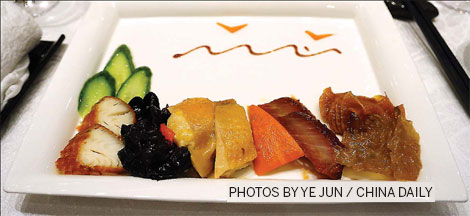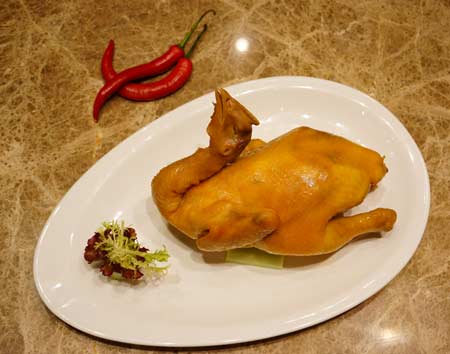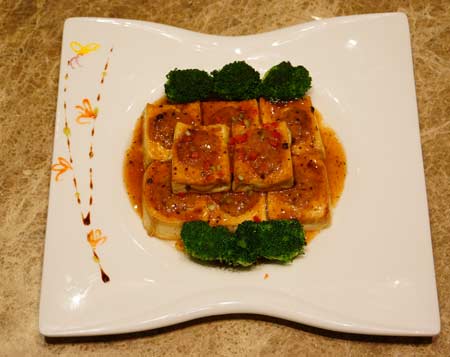A migrants' cuisine migrates
Updated: 2012-05-05 07:53
By Ye Jun (China Daily)
|
|||||||||||

Hakka fare's characteristics, which developed in the ancient days when the culture's people relocated as refugees, are gradually spreading throughout the country. Ye Jun reports.
Hakka fare stands out among Chinese food - virtually no other cuisine prepares chicken in hot-fried salt or stuffs pork into tofu.
While Cantonese cuisine is indeed popular, its Hakka branch leaves many scratching their heads. And it's not easy to find places with Hakka food - although it's becoming easier.
Dongjiang Renjia (East River Family) is among the few eateries that serve the cuisine in Beijing.
Dongjiang is a river that flows through such Hakka-inhabited areas as Huizhou and Heyuan in Guangdong province.That's why Hakka cuisine is sometimes called Dongjiang cuisine, explains Liao Gengwen, a Hakka and assistant chef with Sen5es, a Cantonese restaurant in Westin Beijing Chaoyang.
The restaurant developed a new menu of traditional and new Hakka dishes last month that will last through May.
Hakka are ethnically Han people with a distinctive culture and language, in addition to a unique gastronomy.
"In ancient China, entire family groups relocated to avoid warfare or natural catastrophes," Liao says.
"Because locals considered them guests, they started calling themselves 'Hakka', meaning, 'guest families'."
That migration started as early as the Qin Dynasty (221-206 BC) and lasted until the Qing Dynasty (1644-1911).
The Hakka left what is today Central China's Henan province for southern regions, such as Guangdong, Fujian and Jiangxi provinces, the Guangxi Zhuang autonomous region, Hong Kong and Taiwan. They also left for Southeast Asia and Western countries.
Many historical figures, such as the father of the Republic of China Sun Yat-sen, are Hakka.
Encyclopedia Britannica places the global Hakka population at 80 million. But Liao, who is from Guangdong's Meizhou, says there are about 200 million worldwide.
Guangdong's capital Guangzhou is home to 2 million Hakka. And about 60 percent of the population of the province's Shenzhen city are Hakka.
This population accounts for the third school of Cantonese cuisine, after Guangzhou and Chaozhou.
Hakka food is saltier and has bolder flavors than Guangzhou cuisine. It's heavy on poultry, and its fish are freshwater species. Much of the fare is prepared in clay pots.
Baked chicken is perhaps the cuisine's signature dish. It's said that about 300 years ago, Hakka people working in salt fields would wrap chicken in paper and bury it in salt to preserve it.
This dish later moved to restaurants. Chefs marinate the chicken and then fry rock salt until it's sizzling hot. The chicken is then wrapped in paper and baked in fried salt for an hour until it's ready.
Hakka also includes many pickles, such as meigancai (preserved mustard leaf). Meigancai is often made into a dish with brown braised pork that is a classic but is prepared differently in different areas.
"It's said the Hakka faced trouble with food spoiling during their migrations, so they would salt it," Liao says.
Liao's colleague, chef Xie Huanyong, is also a Hakka from Guangdong's Heyuan.
Xie claims Hakka tofu is as famous as Sichuan's mapo doufu. It's said it was invented when a Hakka settlement wanted to make jiaozi (dumplings) for Spring Festival but didn't have flour. Stuffed bean curd is sometimes called the "jiaozi of South China".
Many restaurants give modern twists to traditional Hakka fare, including Hancang Hakka Restaurant on the bank of Beijing's Houhai Lake. This eatery extends the salt-baking method past chickens to prawns.
The eatery's innovative "niang sanbao" ("three treasures with stuffing"), stuffs pork into bell pepper, aubergine and bitter melon, rather than tofu.Other restaurants replace the minced pork with mashed shrimp or fish.
Another signature Hakka delicacy that has surged in popularity in Beijing in recent years is zhudu baoji - stewed chicken with pork tripe. Tripe is stuffed inside the chicken and slow boiled to produce milky white soup. After the meat is devoured, the soup can be used as a hotpot base.
Chenji Hakka Restaurant, a small Guangdong hawker-style eatery in Beijing, has two branches in Wanliuqiao and Shibalidian.
Chenji's signature dish is braised chicken with abalone in clay pot boiled with three bottles of beer. It also proffers other Hakka classics and other Cantonese staples, such as braised fish head in clay pot, roasted pigeon, roasted goose and baozaifan (clay pot rice with preserved sausage).
Sen5es' new Hakka menu demonstrates the cuisine's primary cooking methods with such dishes as salty stewed yellow croaker, simmered free-range chicken with yellow rice wine and deep-fried white eel balls with fermented tofu.
Salt-stews, yellow rice wines and fermented tofu are important elements of Hakka cooking. It's also set apart from Guangzhou cuisine by its sprinklings of chili and peppers.
So, a meat dip is made of minced mint, chilies, green onion and peanut oil. And the chicken and pork tripe soup is typically seasoned with pepper powder.
Xie says Hakka people's preference for salt and spice comes from a history of engaging in hard labor. But that has changed with modernization and the cuisine is increasingly known for its "rural" style and use of the freshest produce. "Hakka people eat what they bought in the market or pulled from the field that morning," Xie says.
Its distinctiveness has led to its growing nationwide popularization since the 1990s, Liao says.
Hakka restaurants have been gobbling up dishes from other styles, especially from Cantonese cuisine's other schools. Conversely, eateries specializing in other cuisines are increasingly devouring Hakka fare for their menus.
There are about 20 Hakka restaurants in Beijing, Liao says. But most are small eateries.
"Hakka hasn't yet occupied a huge portion of China's cuisine composite," he says. "But it has become a distinctive member of its family of foods."

Ingredients (serves 4):
1.5 kg chicken
20 g salt-baked chicken powder (available in supermarkets)
20 g light soy sauce
40 g peanut oil
20 g spring onion
Method:
1. Drizzle light soy sauce on the chicken's skin. Sprinkle salt-baked chicken powder, which contains salt and ginger, on the skin and inside the chicken. Pour peanut oil and spread evenly over the skin and inside the chicken. Put spring onions inside the chicken. Marinate for two hours.
2. Preheat the oven to 200 C. Wrap the chicken in lotus leaves and then in foil. Roast in the oven for 30 minutes.
3. If the chicken is not salty enough, make a sauce with heated peanut oil and salt-baked chicken powder to dip it in.

Recipe | Bean curd stuffed with minced pork
Ingredients (serves 2-3):
400 g beidoufu, or bean curd made with salt coagulant
250 g minced pork belly for stuffing
20 g salt and 5 g starch to mix in pork stuffing
20 g peanut oil
For sauce:
1 teaspoon light soy sauce
1 g white pepper powder
1 teaspoon water
5 g starch
Method:
1. Cut the bean curd into 2.5-cm x 3.5-cm cubes. Open a hole on top of the bean curd tube with a small spoon that is 1.5 cm x 1.5 cm x 1.5 cm. Pack in the minced pork stuffing. Level the pork stuffing with the spoon.
2. Heat a pan and pour in peanut oil. Put in bean curd with the side with pork stuffing facing down. Sautee for two minutes, before pouring in two soup spoons of water at one-third of the height of the bean curd, bring to boil and simmer for four minutes.
3. Mix soy sauce, water, starch and white pepper powder, pour on top of the bean curd and wait another 30 seconds.
4. Sprinkle diced spring onion on top and serve.
Today's Top News
Rescuers race against time for quake victims
Telecom workers restore links
Coal mine blast kills 18 in Jilin
Intl scholarship puts China on the map
More bird flu patients discharged
Gold loses sheen, but still a safe bet
US 'turns blind eye to human rights'
Telecom workers restore links
Hot Topics
Lunar probe , China growth forecasts, Emission rules get tougher, China seen through 'colored lens', International board,
Editor's Picks

|

|

|

|

|

|





